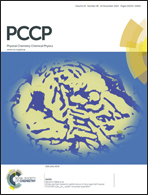A comprehensive study of isomerization and protonation reactions in the photocycle of the photoactive yellow protein†
Abstract
The light-activated photoactive yellow protein (PYP) chromophore uses a series of reactions to trigger photo-motility and biological responses, and generate a wide range of structural signals. To provide a comprehensive mechanism of the overall process at the atomic level, we apply a CASPT2//CASSCF/AMBER QM/MM protocol to investigate the relaxation pathways for a variety of possible isomerization and proton transfer reactions upon photoexcitation of the wild-type PYP. The nonadiabatic relay through an S1/S0 conical intersection [CI(S1/S0)] is found to play a decisive major role in bifurcating the excited state relaxation into a complete and short photocycle. Two major and one minor deactivation channels were found starting from the CI(S1/S0)-like intermediate IT, producing the cis isomers pR1, ICP, and ICT through “hula twist”, “bicycle pedal” and one-bond flip isomerization reactions. The overall photocycle can be achieved by competitive parallel/sequential reactions, in which the ground state recovery is controlled by a series of slow volume-conserving bicycle pedal/hula twist and one-bond flip isomerization reactions, as well as fast protonation–deprotonation processes and the hydrophobic–hydrophilic state transformation.


 Please wait while we load your content...
Please wait while we load your content...